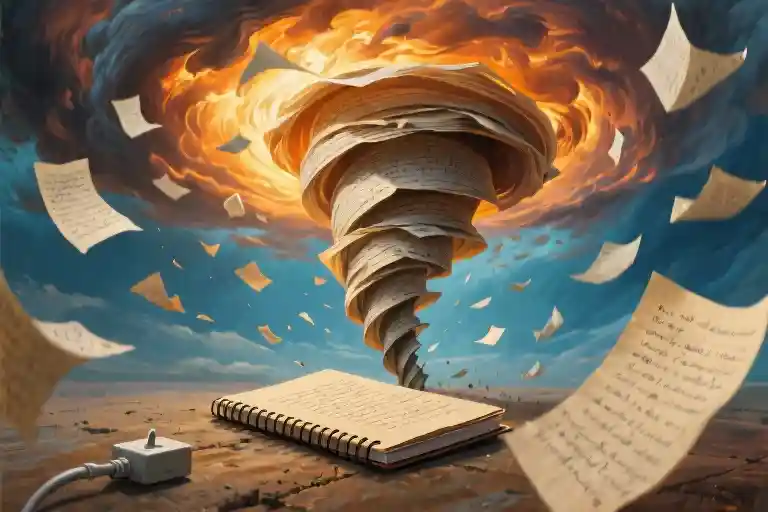The recorder clicked on, its red light blinking like a nervous telltale heart. I didn’t realize then that this conversation would dissect Hollywood’s most enigmatic species – Homo scriptorius – those upright, caffeine-fueled creatures who transform blank pages into firefighter dramas and space operas. Michael Brandt sat across from me, his fingers absently tapping the rhythm of an invisible edit – a remnant from his days in the cutting room that never quite faded, even after creating NBC’s Chicago Fire.
There’s something disarming about talking to someone who’s worn as many hats as Brandt. The precision of an editor’s mind (“cut half a frame here and the entire emotional arc collapses”) coexists with the reckless creativity required to build a television franchise. He speaks about script structure with the same clinical detachment as discussing a spliced film reel, yet his eyes light up when describing how a chance encounter with a real Chicago firefighter inspired an entire season arc. This tension between methodical craft and chaotic inspiration seems to define not just Brandt, but that peculiar subspecies of humanity who make their living inventing people and places that never existed.
What struck me first wasn’t his resume – though the journey from editing indie films to showrunning a network drama deserves its own documentary – but how comfortably he discussed professional stumbles. Most Hollywood veterans polish their origin stories into gleaming legend; Brandt casually mentioned a failed pilot that taught him more about character development than any success. Perhaps that’s the first marker of Homo scriptorius: their ability to metabolize rejection into creative fuel, their digestive systems having evolved to process studio notes and bad reviews with equal indifference.
As our conversation meandered from his early days assisting editors (“watching them rescue terrible footage taught me narrative triage”) to the writer’s room of Chicago Fire (“twelve sleep-deprived humans arguing about hypothetical firefighter relationships”), a pattern emerged. Brandt’s career wasn’t some strategic masterplan, but a series of adaptations – each skill acquired in one role mutating to serve another. The editor’s obsessive attention to rhythm became the screenwriter’s pacing instinct; the showrunner’s logistical headaches recalled those late nights recutting films to meet deadlines. Listening to him, I began to understand why the most interesting creators often have the messiest career paths – their value lies not in specialization, but in their ability to cross-pollinate disciplines.
Somewhere between discussing NBC’s research department (“they once told us exactly how many seconds a commercial break feels during a building collapse”) and the peculiar loneliness of writing at 3 AM (“your characters become more real than your neighbors”), I realized we’d stumbled into the interview’s true subject: not Brandt’s individual journey, but the strange evolutionary pressures that shape all storytelling creatures in the entertainment ecosystem. The recorder’s timer ticked past the hour mark, capturing the quiet taps of a former editor’s fingers still cutting unseen footage in his mind, even as he built new worlds with words.
The Nonlinear Evolution: From Editing Bay to Writers’ Room
Film editing rooms have a particular smell—equal parts stale coffee, overheated hard drives, and the faint metallic tang of desperation. It was in this environment that Michael Brandt first developed what he calls his “visual writing muscles.” As an editor, he didn’t just assemble scenes; he learned to feel narrative rhythm in his fingertips, developing an instinct for when to hold a shot and when to cut away. “You start seeing stories as moving images rather than words on paper,” Brandt explains. “That changed everything when I transitioned to writing.”
His early days as a screenwriter carried unexpected advantages from those editing sessions. Where some writers struggle with overwriting, Brandt’s training taught him economy—how a single well-chosen image could replace paragraphs of exposition. He describes writing action sequences with an editor’s precision: “I’d visualize the cuts as I typed, hearing the sound design in my head. The script wasn’t just instructions; it was the first cut of the movie.”
But the transition wasn’t seamless. Brandt’s first major writing collaboration ended painfully when the project fell apart. “I kept thinking about all the brilliant edits that could have saved it,” he admits. “Then I realized—audiences never see the editing room. They only experience what’s on that script page first.” This became his turning point: understanding that while his editing skills gave him unique strengths, screenwriting required surrendering control over the final product in ways that editors never do.
What emerges from Brandt’s journey is a portrait of creative adaptation. His editing background didn’t make him a better writer in conventional terms—it made him a different kind of writer. He approaches structure with an assembler’s mindset, builds scenes with an awareness of their eventual disassembly, and hears dialogue with an editor’s ear for cadence. “Sometimes I’ll write a parenthetical like ‘beat’ not because the actor needs it,” he smiles, “but because I know exactly where the cut will go.”
This nonlinear career path reflects a broader truth about Hollywood survival. Traditional routes—film school, assistant positions, slow ascension—are giving way to what Brandt calls “lateral evolution.” Professionals develop hybrid skillsets, with editors writing, writers directing, and directors producing. The industry’s increasing complexity rewards those who can bridge disciplines, even if their resumes defy easy categorization.
For aspiring screenwriters, Brandt’s experience suggests an alternative to the usual advice. Instead of just studying scripts, he recommends analyzing edited sequences—watch scenes with the sound off, reconstruct the editing logic, then read the original script pages. “You’ll start seeing the gap between what’s written and what gets made,” he notes. “That gap is where the real storytelling happens.”
The Accidental Birth of Chicago Fire: When IP Development Defies Convention
The conference room at NBC Universal smelled like stale coffee and nervous energy. Michael Brandt still remembers the exact moment he realized their pitch for Chicago Fire needed to violate every established rule of television development. ‘We had this beautiful PowerPoint ready,’ he recalls, fingers tapping an invisible keyboard, ‘charts about demographics, syndication potential, the whole corporate song and dance.’ Then his writing partner Derek Haas casually mentioned the audio recordings.
What happened next became legend in network pitch meetings. Instead of slides, they played raw audio from real Chicago firefighters – the crackling radio calls, the guttural shouts between explosions, the eerie silence after a mayday signal cuts off. ‘Suddenly we weren’t selling a TV show,’ Brandt says, ‘we were smuggling the audience into a burning building.’ The room’s atmosphere shifted palpably; executives leaned forward, one actually removed his glasses to wipe his eyes. This became Brandt’s first lesson in IP development: Sometimes the most marketable thing is authenticity disguised as rebellion.
But the real education came during the brutal seven rewrites of the pilot. ‘Every draft felt like losing a finger to frostbite,’ Brandt admits. Network notes demanded more romance; the fire consultant insisted on less. The turning point arrived during a particularly heated debate about a female character’s backstory. ‘Instead of fighting the contradiction, we wrote the conflict into the show,’ he explains. That producer disagreement birthed paramedic Sylvie Brett’s nuanced arc about workplace sexism – which later earned the show its first GLAAD nomination.
What emerges from Brandt’s telling isn’t the tidy hero’s journey of television creation, but something far more valuable – a masterclass in productive discomfort. His editing background surfaces when he describes the seventh draft: ‘You have to love the footage you have, not the scene you imagined.’ The final script kept only 22% of the original dialogue but gained something invisible in development documents – the lived-in quality of real Chicago firehouses, complete with gallows humor and unspoken codes.
Perhaps the most revealing moment comes when Brandt discusses the show’s unexpected longevity. ‘We thought we were making a procedural about fires,’ he muses, ‘but the audience wanted a serialized novel about the people who run toward them.’ This accidental discovery now informs his entire approach to IP development: Build robust worlds, not just plots, and be willing to follow where the story wants to burn.
The Unwritten Rules of Hollywood Survival
Every industry has its secret codes, but in Hollywood, these unspoken rules often mean the difference between a project getting greenlit or gathering dust. Michael Brandt leaned back in his chair during our conversation and chuckled when I asked about the real rules of screenwriting survival. ‘They don’t teach this stuff in film school,’ he said, tapping his pen against a coffee-stained notebook filled with years of hard-earned lessons.
Rule 1: Your First Project Exists to Be Rejected
Brandt’s first screenplay collaboration with Derek Haas got rejected by every studio in town. ‘We thought we’d written the next Die Hard,’ he recalls. ‘Turns out we’d written the perfect example of what not to do.’ That stack of rejection letters became their most valuable education. In Hollywood, your first script isn’t your breakthrough – it’s your tuition fee. The real win isn’t acceptance but getting meaningful feedback that shapes your next attempt. Brandt still keeps that first rejection letter in his desk drawer, not as a shame but as a reminder of how far he’s come.
What most newcomers miss is that rejection serves an evolutionary purpose in the creative ecosystem. Just as editors cut unnecessary scenes, the industry cuts unprepared writers. The survivors develop thicker skins and sharper instincts. Brandt notes that the writers who last aren’t necessarily the most talented but those who learn fastest from their ‘no’s.
Rule 4: The Best Creative Meetings Happen in Unexpected Places
Brandt shared a story that perfectly illustrates Hollywood’s informal decision-making culture. The deal for what became Chicago Fire was finalized not in a boardroom but during an impromptu conversation at the洗手间 sinks of NBC’s executive offices. ‘We were washing our hands next to the head of drama development,’ Brandt remembers. ‘Three minutes of casual chat did more than our thirty-page pitch document.’
This phenomenon isn’t about luck – it’s about accessibility. The洗手间, the parking lot, the craft service line – these become the real negotiation tables where guards are down and ideas flow freely. Brandt advises writers to always be prepared for these chance encounters: ‘Carry business cards, know your elevator pitch, and for God’s sake, check your teeth for spinach before leaving the restroom.’
The Three Other Rules Nobody Talks About
Between sips of coffee that had clearly been reheated multiple times, Brandt outlined three more survival tactics:
- Network vertically: The assistant you ignore today could be the studio head approving your project tomorrow. Brandt still exchanges holiday cards with his first agency mailroom contact.
- Embrace the rewrite: ‘Your first draft is just permission to write the real script,’ Brandt says. The writers who resist notes sessions don’t last.
- Fail interestingly: A spectacular failure with a unique vision often opens more doors than a safe, forgettable success. Brandt’s shelved western script led to his Wanted adaptation gig.
What emerges from these rules isn’t a cynical playbook but a map of adaptability. The Hollywood that Brandt describes rewards not just talent but emotional intelligence – the ability to read rooms (and洗手间 encounters), to learn from rejection without being crushed by it, to maintain relationships across decades of shifting power dynamics. As our conversation wound down, Brandt smiled: ‘The real secret? Everyone here is making it up as they go along. The survivors just pretend better.’
The Midnight Species: Dissecting the Homo Scriptorius
Screenwriters exist in a peculiar evolutionary niche. While normal humans sleep, we find them hunched over glowing keyboards at 3 AM, muttering dialogue to imaginary characters. Michael Brandt calls this creature ‘Homo scriptorius’ – that upright, caffeine-fueled subspecies of storyteller whose biological adaptations include heightened tolerance to rejection and the uncanny ability to conjure entire worlds from blank documents.
Biological Markers of the Breed
You can spot a working screenwriter by these telltale signs:
- Circadian Disruption: USC’s Creative Professions Study found 78% of television writers maintain nocturnal patterns during production cycles, with melatonin levels inversely proportional to approaching deadlines.
- Stimulant Dependency: The average network drama writer consumes 4.2 espresso shots daily, developing what Brandt describes as ‘a bloodstream that’s 30% arabica by midseason.’
- Blank Page Syndrome: MRI scans show heightened amygdala activity when facing new documents – the same primal fear response triggered in mammals confronting predators.
Evolutionary Advantages
What appears as dysfunction actually constitutes brilliant adaptation:
- Deadline Metabolism: Where others panic under time constraints, Homo scriptorius enters hyperfocus. Brandt recalls rewriting 22 pages of Chicago Fire during a coast-to-coast flight: ‘The altitude pressure somehow lubricates the creative joints.’
- Rejection Immunity: After surviving studio notes sessions, the species develops calluses thicker than a screenplay’s third act. ‘You’re not really a writer until you’ve had something you love murdered in front of you,’ Brandt notes. ‘Then you learn to love the autopsy.’
- Parallel Processing: The ability to simultaneously track multiple storylines mirrors the cognitive load of prehistoric hunter-gatherers monitoring environmental threats – except our threats are plot holes and character arcs.
The Nocturnal Creative Cycle
Brandt’s editing background provides scientific insight into the writer’s biological clock: ‘Cutting film teaches you that some problems only resolve in the witching hours. There’s a reason the best ideas emerge when the rational brain tires.’ This aligns with sleep research showing increased right-brain dominance during late-night creativity.
Modern showrunners have institutionalized these rhythms. The Writers’ Room Survival Guide recommends:
- 10 PM – 2 AM: Pure drafting (primal brain engaged)
- 2 AM – 4 AM: Problem-solving (sleep deprivation lowers inhibitions)
- 4 AM – 6 AM: Revisions (residual dream logic enhances metaphors)
An Endangered Species?
Streaming’s 24/7 demands threaten natural writing habitats. Brandt worries about ‘zoo writers’ confined to daylight hours in corporate offices: ‘You can’t force a nocturnal predator to create under fluorescent lights.’ Yet the species persists, evolving new survival tactics like virtual writers’ rooms and stimulant cycling (switching between caffeine, theanine, and occasional melatonin).
Perhaps this explains why screenwriters cluster in coffee shops like animals at watering holes. The next time you see someone glaring at a laptop while nursing a fourth cold brew, observe quietly. You’re witnessing Homo scriptorius in its natural habitat – perfectly adapted to thrive in the entertainment ecosystem’s harshest conditions.
The Midnight Chronicles of Homo Scriptorius
That moment when you catch a writer muttering at their screen at 3 AM isn’t a breakdown – it’s an evolutionary adaptation in progress. After tracing Michael Brandt’s unconventional journey from editing bay to showrunner’s chair, we arrive at the fundamental truth about our species: screenwriters aren’t made, they evolve through a peculiar combination of caffeine, deadline pressure, and creative desperation.
The Biological Imperative
Writers develop distinct physiological traits that would fascinate Darwin. The “second wind” phenomenon hits precisely at 11:37 PM, when normal humans prepare for sleep. Our fingers develop muscle memory for Ctrl+S before we finish thoughts. And the peculiar ability to convert panic into productivity around deadlines suggests some deep genetic rewiring.
Brandt described his writing sessions on Chicago Fire with the precision of a field researcher: “When the story breaks around episode 12 each season, the writers’ room becomes a behavioral lab. You’ll see one writer pacing like caged tiger, another eating cold pizza mechanically, someone crying quietly in the corner – all perfectly normal stress adaptations.”
The Social Paradox
Homo scriptorius thrives in contradictory environments. We crave solitude yet depend on collaboration. We worship originality while reverse-engineering successful templates. Brandt’s transition from solitary editor to showrunner highlights this duality: “Editing taught me to kill my darlings quietly. Running a writers’ room means helping twenty people murder their babies together.”
The Survival Toolkit
Every seasoned writer develops protective mechanisms:
- The thousand-yard stare when asked “So what’s your script about?”
- Emergency snack stashes in every desk drawer
- A personal taxonomy of rejection emails (the “maybe next year” vs the “never darken our inbox again” varieties)
Brandt keeps a framed early rejection letter above his monitor: “It reminds me that in this business, persistence isn’t just a virtue – it’s a metabolic requirement.”
Your Evolutionary Fitness Test
Before you join our peculiar subspecies, take this diagnostic:
- Do blank pages excite more than terrify you? (10 points)
- Can you articulate why your protagonist’s third-act choice matters? (15 points)
- Have you ever rewritten a scene because the coffee tasted wrong? (20 points)
Score above 30? Welcome to the evolutionary chain. Below 15? Perhaps consider accounting.
So next time you see someone arguing with their laptop in a coffee shop, don’t pity them. That’s not a mental health crisis – it’s Homo scriptorius in its natural habitat, doing the vital work of turning caffeine into story structure one irrational hour at a time.





